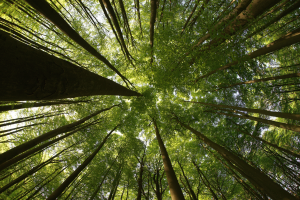Lesedauer ca. 3 Minuten Study: A comparatively large amount of carbon from the atmosphere is also bound in the soil under old trees. Thus, old trees make an important contribution to climate protection above and below ground. This must be taken into account in timber harvesting if climate protection in the forest is to gain in value.
climate
Nitrogen input in forests: a fertilizer to cut both ways
Lesedauer ca. 2 Minuten Study: The researchers show how that the Nitrogen input in forests has much more impact than the climate change so far. The data came from 100,000 coniferous and deciduous trees in 442 even-aged pure stands from 23 European countries.
Big birds need old trees
Lesedauer ca. 3 Minuten Study: The researchers found that the rate of decay of the deadwood is influenced by the tree species, temperature and precipitation. The shortest deadwood residence times were for wood derived from beech (F. sylvatica). In the warmest locations 90% of the biomass had decomposed after 27 years, in the average locations after 35 years and in the coldest locations after 54 years.
Burning wood is not climate-neutrale
Lesedauer ca. 2 Minuten position e-paper: Burning wood is not climate-neutral this clarifies a team of scientists around Prof. Dr. Pierre Ibisch from the University for Sustainable Development in Eberswalde (HNEE, Germany) on the basis of worldwide research work. Even the use of wood in durable products can be detrimental to the climate – especially when the harvesting of wood impairs the functionality of forests.
Deadwood can remain in forests for generations
Lesedauer ca. 3 Minuten Study: The researchers found that the rate of decay of the deadwood is influenced by the tree species, temperature and precipitation. The shortest deadwood residence times were for wood derived from beech (F. sylvatica). In the warmest locations 90% of the biomass had decomposed after 27 years, in the average locations after 35 years and in the coldest locations after 54 years.
Canopy protects forest organisms from global warming
Lesedauer ca. 2 Minuten Study: The leaf canopy of the forests functions like an insulating layer. This protects the organisms living under it from the effects of global warming. On average, the maximum temperatures in the forest are 4°C lower than in the open. This shows how important the buffer effect of forests can be in climate change.





